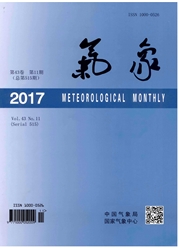

 中文摘要:
中文摘要:
实际观测表明雨滴谱的谱形参数(胁)具有显著的时空分布特征,而微物理参数化方案中往往将其设定为常数。基于WRF3.5,1模式中的Milbrandt 2-mon(MY)双参数方案,针对四次典型的江淮梅雨降水过程,利用江淮梅雨的实际雨滴谱观测资料结果,分析MY方案中诊断雨滴谱谱形参数的处理方法对梅雨降水模拟效果的影响。结果表明:利用雨滴谱斜率诊断以的处理方式对梅雨降水的系统性偏差有一定的改善能力,对降水落区分布的局地性特征能够发挥一定的修正作用。较强降水对胁的完善表现出更显著的改善倾向。耦合经验公式后,胁总体增加,对流层中低层的肼随降水强度增加而降低。与以直接相关的雨滴质量加权末速度的增加和雨水含水量的减小是改进试验中降水变化的直接原因。环境场的水汽与动力条件的改变是降水变化的重要间接原因,云物质的响应变化以及降水位置强度的宏观特征演变与此密切相关。强弱降水的改善程度的差异主要源于各自物理量场的响应特征的不同。强降水的暖云云物质特征变化趋势虽与弱降水时一致,但变化幅度等差异显著。弱降水时,物理量场对胁的响应特征表现出较为一致的变化趋势和一定的线性特征;而强降水条件下,云物理过程以及同环境条件之间的反馈作用更加复杂,冰云和环境场的响应特征往往没有显著规律可循。
 英文摘要:
英文摘要:
The raindrop spectrum shape parameter, which has significant spatio-temporal distribution features, is set as a constant in the Double-moment Bulk Microphysics Scheme (DBMS) using Gamma distri- bution function. Based on Milbrandt 2-mon (MY) DBMS, four Meiyu precipitation cases are simulated coupled with four empirical relationships between shape parameter (μr) and slope parameter of raindrops which are concluded from the observations of raindrop distribution. The analysis results suggest that μr has some influences on precipitation. Adopting the diagnostic formulas of μr is positively helpful for improving systematic biases of Meiyu rainfall and shows certain correction ability to the localization of rainfall distribution. The good response of heavy precipitation to μr reflects the clear tendency of improvement. Calculated by the empirical formula, μr increases generally. In the mid- and lower-troposphere, μr decreases with the increase of rainfall intensity. The decline in raindrop water content and the increased raindrop mass-weighted average terminal velocity, which is directly related to/2r, are the direct causes for the changes of precipitation. The difference in improving degree between the light and heavy rainfalls mainly results from the different response features of their variable fields. The varying trend of warm- cloud particle features of severe rainfalls is consistent with that of light rainfalls, but there are considerable differences in their varying degrees. While it rains lightly, the response characteristics of physical fields to μr present similar varying trends and some linear features. However, in the case of heavy precipitation, the cloud microphysical process and ambient condition experience complex interactions with each other and no significant laws can be followed.
 同期刊论文项目
同期刊论文项目
 同项目期刊论文
同项目期刊论文
 期刊信息
期刊信息
